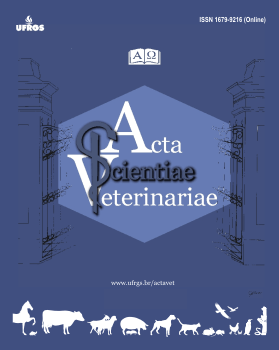Saliva Crystallization in Sheep Subjected to Estrus Induction and Synchronization Protocols
DOI:
https://doi.org/10.22456/1679-9216.97772Abstract
Background: The crystallization of bodily fluids, primarily saliva, has been the subject of study in many species and is a simple alternative to detect estrus because it demands neither a significant financial investment nor qualified professionals to execute the examination. Fern pattern crystallization has been described in the cervical and nasal mucus, saliva and tear secretion, and in colostrum. Changes in salivary crystallization during the reproduction cycle are related to different hormonal concentrations in this period. Thus, the present study has evaluated the patterns of saliva crystallization in sheep subjected to estrus induction and synchronization protocols.
Materials, Methods & Results: The sample consisted of 11 crossbreed Corriedale sheep, which were evaluated during two experimental periods (spring and autumn), and that underwent induction and synchronizing estrus protocols. In a random phase of the estrus cycle (day 0), each sheep was implanted with an intravaginal device (Primer®), impregnated with 0.36 g of progesterone for seven days. This device was inserted according to manufacturer’s instructions of the manufacturer and with the assistance of a specific applicator. On the day of device removal (day 7), the animals received 0.0375mg of D-Cloprostenol (Prolise®) and 10 mg of Folltropin extracted from the swine pituitary (NIH-FSH-P1 of Folltropin-V - Folltropin®) by intramuscular administration. The saliva was collected at six points during the experimental periods: day 1 (3 days before placement of the implant); day 4 (day of insertion of the implant); day 9 (5 days after the insertion of the implant); day 11 (day of removal of the implant and application of hormones); day 12 (24 h after removal of the implant [presumable estrus]); and day 13 (48 h after removal of the implant). Smears containing 10µ L of saliva were observed under an optical light microscope (200 x magnification) for assessment of saliva crystallization. Salivary crystallization was classified in scores from 0 to 3 based on the extent of crystallization observed in the slide, also considering filling of the observation field (x 200) and type of arborization pattern observed, as follows: 0 = without crystallization; 1 = too little crystallization; 2 = low crystallization; and 3 = large amount of crystallization. The patterns of crystallization found in sheep demonstrated an increase in quantity, diversity, definition, and size of sheets as the period of estrus approached and were different than those tipically described in the literature. Patterns of salivary crystallization followed the phases of the estrus cycle defined by the estrus induction and synchronization protocol.
Discussion: Salivary crystallization in the sheep used in this study exhibited patterns that were different than those typically described in the literature. In the spring, salivary crystallization score demonstrated variation from day1 to 11 of the protocol, when the predominant hormone was progesterone released by the implant (diestrus). However, in Autumn, on day 4 (implant placement day), an increase in crystallization score was noted. This may have occurred because the sheep were in the reproductive season and therefore, may have been nearing seasonal estrus before placement of the implant. The patterns of crystallization found in sheep demonstrated an increase in quantity, diversity, definition, and size of sheets as the period of estrus approaches and showed patterns that were different than the ones usually described in literature. The patterns of salivary crystallization followed the phases of the estrus cycle defined by the estrus induction and synchronization protocol.
Downloads
References
Barrett D.M.W., Bartlewski P.M., Duggavathi R., Davies K.L., Huchkowsky S.L., Epp T. & Rawlings N.C. 2008. Synchronization of follicular wave emergence in the seasonally anestrous ewe: The effects of estradiol with or without medroxyprogesterone acetate. Theriogenology. 69(7): 827-836.
Gnanamuthu G. & Rameshkumar K. 2015. Determination of estrus in umblachery cattle (Bos indicus) by salivary fern pattern. International Journal for Species. 13(41): 68-78.
Kubátová A. & Fedorova T. 2016. Saliva crystallization occurs in female bornean orangutans (Pongo pygmaeus): Could it be a new option for monitoring of menstrual cycle in captive great apes? PLoS One. 11(7): 1-11.
Pardo-Carmona B., Moyano M.R., Fernández-Palacios R. & Pérez-Marín C.C. 2010. Saliva crystallisation as a means of determining optimal mating time in bitches. Journal of Small Animal Practice. 51(5): 437-442.
Ravinder R., Kaipa O., Baddela V.S., Singhal Sinha E., Singh P., Nayan V., Velagala C.S.N., Baithalu R.K., Onteru S.K. & Singh D. 2016. Saliva ferning, an unorthodox estrus detection method in water buffaloes (Bubalus bubalis). Theriogenology. 86(5): 1147-1155.
Sangeetha P. & Rameshkumar K. 2015. Detection of Estrus in Sheep (Ovis aries) by Salivary Fern Pattern and Vaginal Cytological Examination with Relation to Estrogen. The Scitech Journal. 2(5): 29-33.
Skalova I., Fedorova T. & Brandlova K. 2013. Saliva Crystallization in Cattle: New Possibility for Early Pregnancy Diagnosis? Agricultura Tropica et Subtropica. 46(3): 102-104.
Weber P.C. 1991. Physical Principles of Protein Crystallization. Advances in Protein Chemistry. 41: 1-36.
Published
How to Cite
Issue
Section
License
This journal provides open access to all of its content on the principle that making research freely available to the public supports a greater global exchange of knowledge. Such access is associated with increased readership and increased citation of an author's work. For more information on this approach, see the Public Knowledge Project and Directory of Open Access Journals.
We define open access journals as journals that use a funding model that does not charge readers or their institutions for access. From the BOAI definition of "open access" we take the right of users to "read, download, copy, distribute, print, search, or link to the full texts of these articles" as mandatory for a journal to be included in the directory.
La Red y Portal Iberoamericano de Revistas Científicas de Veterinaria de Libre Acceso reúne a las principales publicaciones científicas editadas en España, Portugal, Latino América y otros países del ámbito latino





